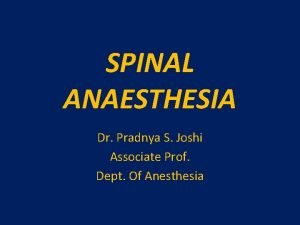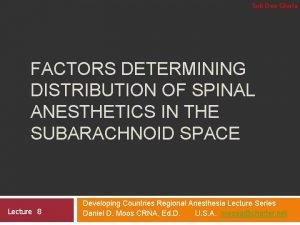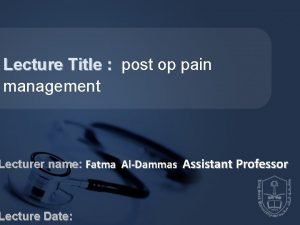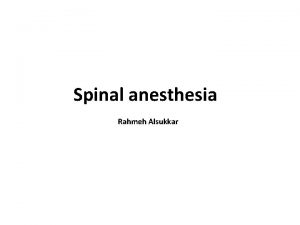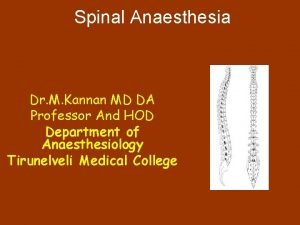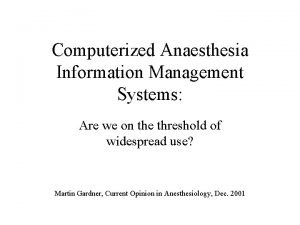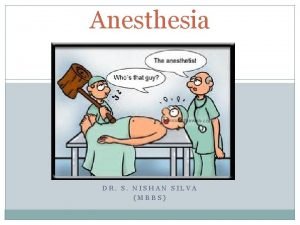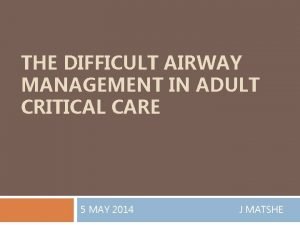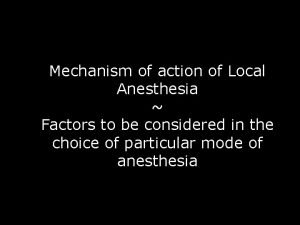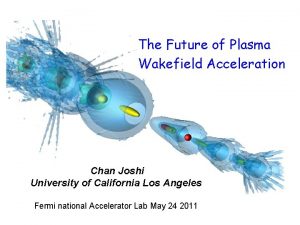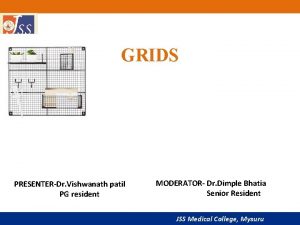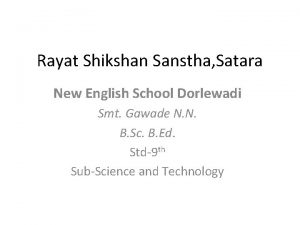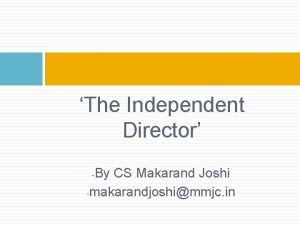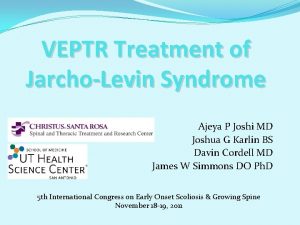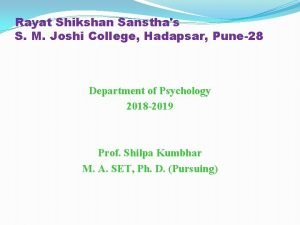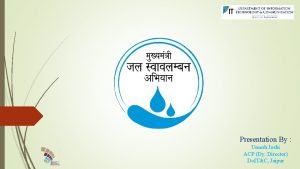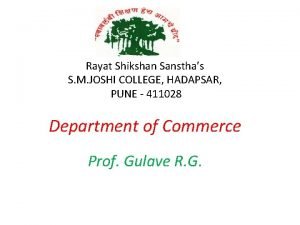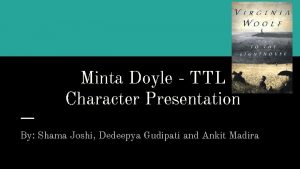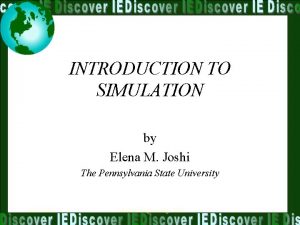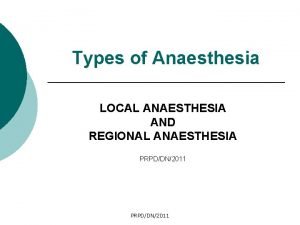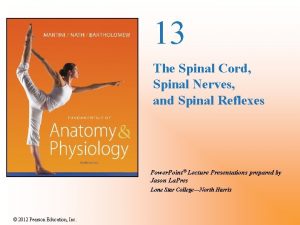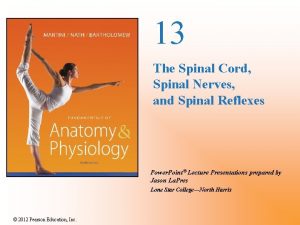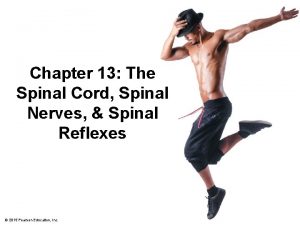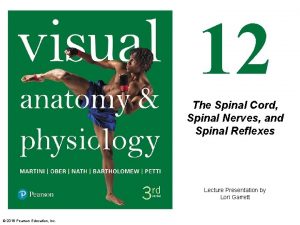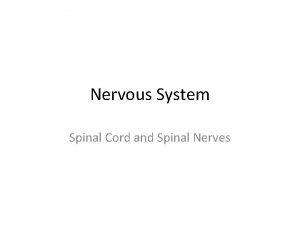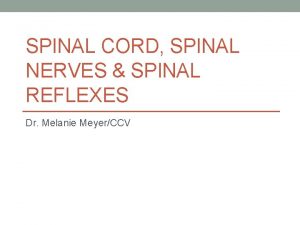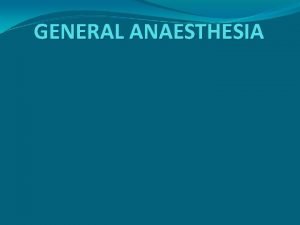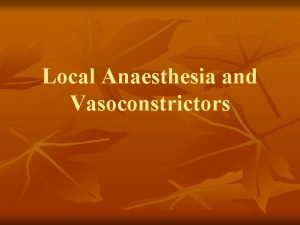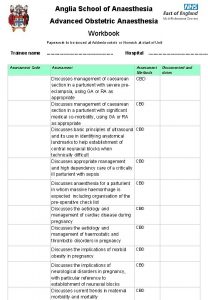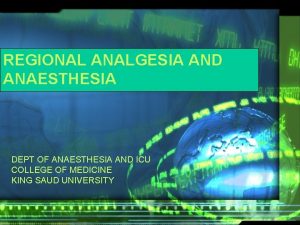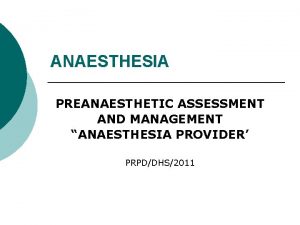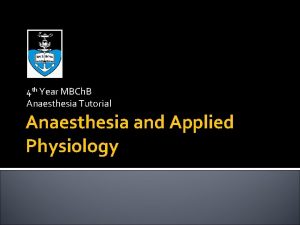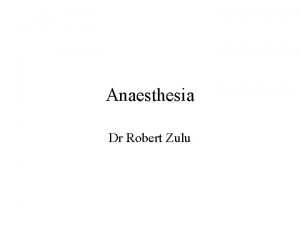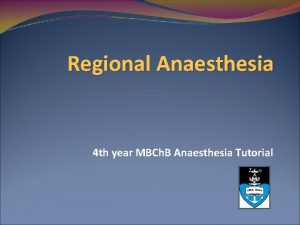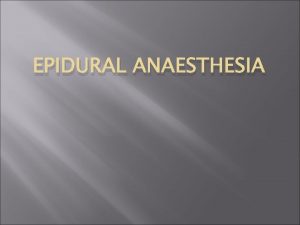SPINAL ANAESTHESIA Dr Pradnya S Joshi Associate Prof







































- Slides: 39

SPINAL ANAESTHESIA Dr. Pradnya S. Joshi Associate Prof. Dept. Of Anesthesia

LEARNING OBJECTIVES At the end of the lecture, the student shall be able to • Describe anatomy of spinal cord • Enumerate physiological effects of spinal anaesthesia on various systems • Enumerate indications & contraindications of spinal anaesthesia • Enumerate advantages & disadvantages of spinal anaesthesia • Enumerate complications of S. A.

ANATOMY OF SPINE • Spine : composed vertebral bones & fibro cartilaginous discs. There are : 7 cervical : 12 thoracic : 5 lumbar : sacrum which is a fusion of 5 sacral vertebrae : Coccyx 4 -5

VERTEBRAL COLUMN Four curves: Cervcial &lumbar convex anteriorly (lordosis). Thoracic & sacral concave anteriorly (kyphosis) Spinal nerves: 8 cervical 12 thoracic 5 lumbar 5 sacral 1 coccygeal. Total 31

SPINAL CORD • Spinal cord continues cephalad with brain stem through foramen magnum and terminates distally in the conus medullaris at lower border of L 1 in adults and upper border of L 3 in children.

SPINAL CORD Meningeal coverings: From with in to periphery • Pia mater • Arachanoid membrane • Dura mater


SUBARACHANOID SPACE Lies between pia mater and arachnoid mater, ends at S 2 Contents: • CSF • Spinal nerves • Blood vessels supplying spinal cord


CIRCULATION OF CSF Choroid plexus in lateral ventricles Foramen of Monroe 3 rd ventricle Aqueduct of Sylvius 4 th ventricle Foramen of Luschke and Magendie Subarachanoid space. Re absorption of CSF occurs in arachanoid villi.

August Bier 1885

AUTONOMIC NERVOUS SYSTEM Has 2 components: • Sympathetic fibers Arises from T 1 - L 2 segment. • Parasympathetic fibers From craniosacral segment Cranial nerves giving rise to parasympathetic fibers: 3, 7, 9, 10 Sacral fibers arises from S 2, S 3, S 4 spinal segment.

• S. A. results in predominantly sympathetic blockade , because parasympathetic fibers carried by vagus have higher origin

MECHANISM OF ACTION • Site of action for neuraxial blockade in sub arachnoid space: nerve roots • Blockade of posterior nerve roots interrupts somatic and visceral sensation. • Blockade of anterior nerve root fibers prevents efferent motor and autonomic outflow.

ORDER OF BLOCKING NERVE FIBRES • • • Autonomic fibers Temperature fibers Pain fibers Touch fibers Somatic motor fibers

• • • T 4 ---Nipple T 5 ---Inframammary fold T 6 ---Xiphoid T 10 ---Umbilicus L 1 ---Groin S 2 -4 ---Perineum.

CVS CHANGES HYPOTENSION Occurs because of venous and arterial dilatation BRADYCARDIA Blockade of cardiac sympathetic fibers -> decrease in H. R.

EFFECTS ON GIT • Nausea and vomiting caused by unopposed parasympathetic (vagal) activity • This also results in small contracted gut which provide excellent operative conditions.

URINARY TRACT MANIFESTATIONS • Blockade of both sympathetic and parasympathetic control of bladder function results in urinary retention.

ADVANTAGES • • Low cost Decrease blood loss Less metabolic derangement Better for severe respiratory impairment Allows verbal communication Postoperative Analgesia Avoid complications of G. A.

DISADVANTAGES • • Discomfort in prolonged surgeries Potential of nerve damage Introduction of infection in CSF Post operative leg weakness & urinary retention

INDICATIONS • Primary anesthetic technique in lower abdominal procedures(LSCS), inguinal hernia repair, urogenital, rectal and lower extremity surgeries. • S. A. preferable in geriartic age group for peripheral orthopaedic , vascular and urological procedures. • Obstetric patients with full stomach

ABSOLUTE CONTRAINDICATIONS Patient refusal Infection at injection site Coagulopathy or bleeding diathesis Low fixed cardiac output states: Severe constrictive pericarditis, cardiac tamponade, severe M. S. , severe A. S. • Severe hypovolemia • Raised ICT • •

RELATIVE CONTRAINDICATIONS • Sepsis • Uncooperative patient • Spinal deformity: congenital, traumatic, post laminectomy • Severe anemia

TECHNIQUE OF S. A. Equipment Spinal needle - small needles reduce the incidence of post dural puncture headache. Drugs • Lidocaine(5%) • Bupivacaine(0. 5%) • Ropivacaine(0. 5%) available in isobaric form only

Spinal Needle

Sitting Position

SITING POSITION LATERAL POSITION

Holding for Spinal


INTRAOPERATIVE COMPLICATIONS Due to exaggerated physiological responses Hypotension Management: • Maintain O 2 supply • IV fluids bolus 0. 5 -1 L • RAISE LEGS • Use of vasopressor drugs like Ephedrine or Mephenteramine

Bradycardia • When PR. < 60/Min • P. R. < 50 - Inj. Atropine 0. 6 mg Inj. Epinephrine 50 -100µg

• • • TOTAL SPINAL BLOCK: Level of block extend above T 1 involving cervical segments Nausea, vomiting, difficulty in breathing, hypotension, bradycardia. Management: Maintain adequate airway & ventilation with 100%O 2 supply. Immediately do intubation Maintain circulation with iv fluids. Vasopressor drugs : Inj. Phenylephrine, Dopamine.

• Urinary retention • Nausea &vomiting

POSTOPERATIVE COMPLICATIONS • • Postdural puncture headache occurs 12 -72 hrs post operatively. Cause Loss of CSF through dural puncture -> decreased ICP -> traction on dura & blood vessels Bilateral frontal or retro orbital or occipital headache. Increases in sitting & relieves in lying down

Management Prevention: • use smaller size needle • Prevention of dehydration Treatment: • Recumbent position, analgesics • I. V or oral fluid administration • I. V. caffeine • Epidural blood patch.

Delayed complications • • Transient neurological symptoms Cranial nerve disturbances Visual and auditory disturbances Paralysis of 6 th cranial nerve Backache Spinal haematoma Meningitis or arachnoiditis


 Dr pradnya joshi
Dr pradnya joshi What is regional anesthesia
What is regional anesthesia Structure pierced in spinal anesthesia
Structure pierced in spinal anesthesia Bromage scale
Bromage scale Layers of spinal anesthesia
Layers of spinal anesthesia Spinal anaesthesia position
Spinal anaesthesia position Lateral pectoral nerve
Lateral pectoral nerve Inferior gluteal nerve
Inferior gluteal nerve Spinal nerves labeled
Spinal nerves labeled Spinal cord and spinal meninges
Spinal cord and spinal meninges Balanced anaesthesia ppt
Balanced anaesthesia ppt Balanced anesthesia components
Balanced anesthesia components Anaesthesia information management system
Anaesthesia information management system Anaesthesia meaning
Anaesthesia meaning Thyromental distance
Thyromental distance Dose of lidocaine
Dose of lidocaine Calcium displacement theory of local anaesthesia
Calcium displacement theory of local anaesthesia Macintosh blade placement
Macintosh blade placement Chan joshi
Chan joshi Saily joshi
Saily joshi Dr hiren joshi
Dr hiren joshi Air gap technique in radiology
Air gap technique in radiology Milind joshi
Milind joshi Madhur joshi
Madhur joshi S m joshi college
S m joshi college Madhura joshi nrdc
Madhura joshi nrdc S.m.joshi college uniform
S.m.joshi college uniform Cs independent
Cs independent Ajeya joshi
Ajeya joshi Sm joshi college hadapsar
Sm joshi college hadapsar Umesh joshi
Umesh joshi S m joshi college
S m joshi college Dr rajan joshi
Dr rajan joshi Dr padmaja joshi
Dr padmaja joshi Calcicitrol
Calcicitrol Shama joshi
Shama joshi Neel joshi md
Neel joshi md Elena joshi
Elena joshi Ashlesha joshi
Ashlesha joshi Customer kpi
Customer kpi
